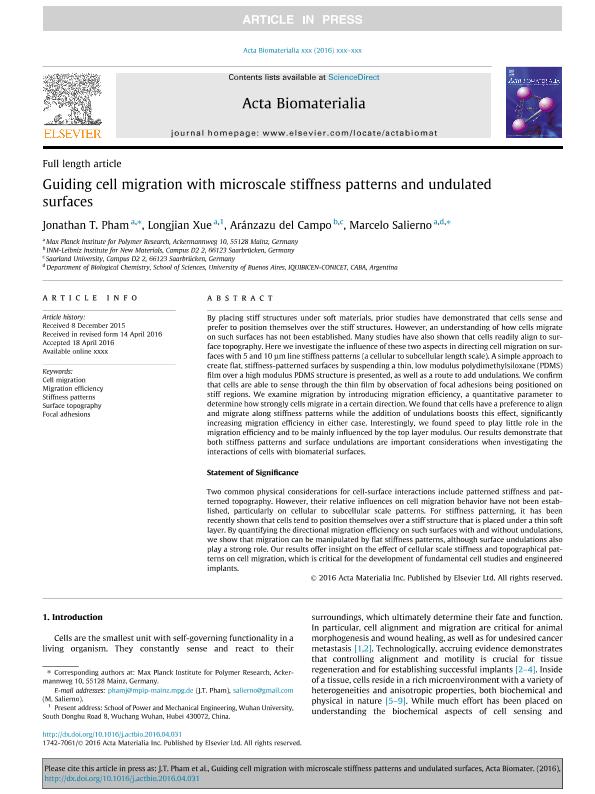Mostrar el registro sencillo del ítem
dc.contributor.author
Pham, Jonathan T.
dc.contributor.author
Xue, Longjian
dc.contributor.author
del Campo, Aránzazu

dc.contributor.author
Salierno, Marcelo Javier

dc.date.available
2018-09-14T19:39:46Z
dc.date.issued
2016-07
dc.identifier.citation
Pham, Jonathan T.; Xue, Longjian; del Campo, Aránzazu; Salierno, Marcelo Javier; Guiding cell migration with microscale stiffness patterns and undulated surfaces; Elsevier; Acta Biomaterialia; 38; 7-2016; 106-115
dc.identifier.issn
1742-7061
dc.identifier.uri
http://hdl.handle.net/11336/59782
dc.description.abstract
By placing stiff structures under soft materials, prior studies have demonstrated that cells sense and prefer to position themselves over the stiff structures. However, an understanding of how cells migrate on such surfaces has not been established. Many studies have also shown that cells readily align to surface topography. Here we investigate the influence of these two aspects in directing cell migration on surfaces with 5 and 10 μm line stiffness patterns (a cellular to subcellular length scale). A simple approach to create flat, stiffness-patterned surfaces by suspending a thin, low modulus polydimethylsiloxane (PDMS) film over a high modulus PDMS structure is presented, as well as a route to add undulations. We confirm that cells are able to sense through the thin film by observation of focal adhesions being positioned on stiff regions. We examine migration by introducing migration efficiency, a quantitative parameter to determine how strongly cells migrate in a certain direction. We found that cells have a preference to align and migrate along stiffness patterns while the addition of undulations boosts this effect, significantly increasing migration efficiency in either case. Interestingly, we found speed to play little role in the migration efficiency and to be mainly influenced by the top layer modulus. Our results demonstrate that both stiffness patterns and surface undulations are important considerations when investigating the interactions of cells with biomaterial surfaces. Statement of Significance Two common physical considerations for cell-surface interactions include patterned stiffness and patterned topography. However, their relative influences on cell migration behavior have not been established, particularly on cellular to subcellular scale patterns. For stiffness patterning, it has been recently shown that cells tend to position themselves over a stiff structure that is placed under a thin soft layer. By quantifying the directional migration efficiency on such surfaces with and without undulations, we show that migration can be manipulated by flat stiffness patterns, although surface undulations also play a strong role. Our results offer insight on the effect of cellular scale stiffness and topographical patterns on cell migration, which is critical for the development of fundamental cell studies and engineered implants.
dc.format
application/pdf
dc.language.iso
eng
dc.publisher
Elsevier

dc.rights
info:eu-repo/semantics/openAccess
dc.rights.uri
https://creativecommons.org/licenses/by-nc-nd/2.5/ar/
dc.subject
Cell Migration
dc.subject
Focal Adhesions
dc.subject
Migration Efficiency
dc.subject
Stiffness Patterns
dc.subject
Surface Topography
dc.subject.classification
Otras Ciencias Biológicas

dc.subject.classification
Ciencias Biológicas

dc.subject.classification
CIENCIAS NATURALES Y EXACTAS

dc.title
Guiding cell migration with microscale stiffness patterns and undulated surfaces
dc.type
info:eu-repo/semantics/article
dc.type
info:ar-repo/semantics/artículo
dc.type
info:eu-repo/semantics/publishedVersion
dc.date.updated
2018-09-14T13:16:15Z
dc.journal.volume
38
dc.journal.pagination
106-115
dc.journal.pais
Países Bajos

dc.journal.ciudad
Amsterdam
dc.description.fil
Fil: Pham, Jonathan T.. Max Planck Institute for Polymer Research; Alemania
dc.description.fil
Fil: Xue, Longjian. Max Planck Institute for Polymer Research; Alemania
dc.description.fil
Fil: del Campo, Aránzazu. Leibniz Institute for New Materials; Alemania. Universitat Saarland; Alemania
dc.description.fil
Fil: Salierno, Marcelo Javier. Max Planck Institute for Polymer Research; Alemania. Consejo Nacional de Investigaciones Científicas y Técnicas. Oficina de Coordinación Administrativa Ciudad Universitaria. Instituto de Química Biológica de la Facultad de Ciencias Exactas y Naturales. Universidad de Buenos Aires. Facultad de Ciencias Exactas y Naturales. Instituto de Química Biológica de la Facultad de Ciencias Exactas y Naturales; Argentina
dc.journal.title
Acta Biomaterialia

dc.relation.alternativeid
info:eu-repo/semantics/altIdentifier/doi/http://dx.doi.org/10.1016/j.actbio.2016.04.031
dc.relation.alternativeid
info:eu-repo/semantics/altIdentifier/url/https://www.sciencedirect.com/science/article/pii/S1742706116301933
Archivos asociados
